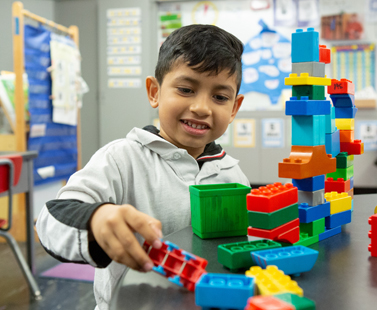Classroom Environment

3) What can I do to set up my classroom environment to support the learning of Multilingual Learners?
Environments should support rich language development through hands-on, inquiry-based, content-rich learning. It is important to create a culturally and linguistically responsive learning environment that shows Multilingual Learner (ML) children that their language and cultural backgrounds are valued and helps them feel comfortable.24 ML children should be able to “see” themselves in the classroom. Interventions that integrate ML-specific classroom materials, such as the ones listed below, with dual language-specific instructional strategies, have been shown to be effective in promoting ML children’s learning.25 These materials should not only be present, but also must be actively used in instruction and easily accessible to children. An environment where multilingualism and diverse cultures are valued is important for all children.
Sample Lesson Plan & Resource Walk
Access additional resources developed to introduce teachers to working in a classroom environment that supports MLs. These activities, a sample lesson plan and a resource walk, are designed to support learning about this instructional topic area through structured exploration of resources on the website. Click the buttons below to access these resources.
Strategies in action



You can search across all strategies by keyword on our Research Search page. Give it a try!
Evidence-Based Strategies and Resources
3A) Include labels and other functional print in the home language. Make sure home language print is on an equal footing with English print (for example, make labels the same size in both languages).
Video
Video: Personalizing Instruction through Environmental Supports
TK
10-15 minutes
TK
Under 5 minutes
TK
More than 60 minutes
Website
Website: Environment and Materials to Support Dual Language Learners
TK
Under 5 minutes
Document
Checklist: Supporting Emergent Bilingual Children in Early Learning
TK
10-15 minutes
Document
Tip Sheet: Creating Environments that Include Children’s Home Languages and Cultures
TK
5-10 minutes
TK
5-10 minutes
3B) Provide books and materials in the home language that depict the cultural and linguistic background of children in a positive light. Make sure children of each language and cultural background can see themselves represented in the classroom.
Other
Digital Book Collection: Level A (Vietnamese)
5-10 minutes
Other
Digital Book Collection: Level B (Vietnamese)
5-10 minutes
Website
Website: Teacher Interactions and Strategies to Support Reading for Dual Language Learners
TK
10-15 minutes
Document
Guide: Selecting and Using Culturally Appropriate Children’s Books in Languages Other than English
TK
15-30 minutes
TK
10-15 minutes
Other
Educator Toolkit: My Name, My Identity- Creating an Inclusive and Respectful School Community
TK
15-30 minutes
Other
Blog: Tackling the Challenges of Implementing Diverse Libraries at Your School
TK
Under 5 minutes
TK
5-10 minutes
TK
10-15 minutes
Other
Website Article: Choosing Diverse Books for Your ELLs – Tips for Educators
10-15 minutes
TK
5-10 minutes
3C) Display and provide culturally relevant materials, including family pictures and cultural items from children’s homes. Include families in helping to select books, objects, and materials to display in the classrooms.
Video
Video: Personalizing Instruction through Environmental Supports
TK
10-15 minutes
Website
Website: Environment and Materials to Support Dual Language Learners
TK
Under 5 minutes
Document
Checklist: Supporting Emergent Bilingual Children in Early Learning
TK
10-15 minutes
Document
Tip Sheet: Creating Environments that Include Children’s Home Languages and Cultures
TK
5-10 minutes
Other
Educator Toolkit: My Name, My Identity- Creating an Inclusive and Respectful School Community
TK
15-30 minutes
Document
Guide: Don’t Underestimate the Power of Contexts in Math Curricula
10-15 minutes
Other
Blog: Tackling the Challenges of Implementing Diverse Libraries at Your School
TK
Under 5 minutes
Other
Website Article: Choosing Diverse Books for Your ELLs – Tips for Educators
10-15 minutes
TK
5-10 minutes
TK
Under 5 minutes

Strategies are interrelated
Individual strategies across the different instructional topics are interconnected and should be implemented together, in a purposeful and connected manner throughout instruction, and not in isolation. Make sure to also consider your classroom or school’s language model when implementing the strategies and adapt accordingly.
Visit how to use this site >

Alignment with Existing California Educator Guidance Documents & Resources
The Multilingual Learning strategies are closely aligned with existing guidance documents and resources for educators in California. Learn how Classroom Environment strategies align with these existing resources, or to see how the standards align across all strategies, visit the alignment reference guide page.

